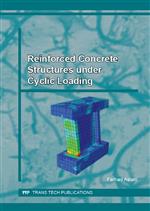Reinforced Concrete Structures under Cyclic Loading

Description:
Experimental programs in laboratories give real results to identify nonlinear behavior of reinforced concrete (RC) structures but they are limited to knowledge of particular cases under restricted structural dimensions, sizes, shapes, loading and boundary conditions but the computational simulation approach has no limit to its application. Constitutive models are developed to simulate the dynamic nonlinear response of concrete and steel reinforcement subjected to cyclic loading varying randomly in magnitude. The behavior of structural concrete under monotonic loading is affected by important material aspects including cracking, crushing, tension stiffening, compression softening and bond slip. Reversed cyclic loading introduces further complexities such as stiffness degradation in concrete and the Bauschinger effect in reinforcing steel. In this research the validity and reliability of some proposed constitutive models for concrete considering general loading i.e. cyclic, monotonic, partial, common point and transition loading are evaluated. Comparisons with test results showed that the proposed model provides a good fit to a wide range of experimentally established hysteresis loops.
Purchase this book:
eBook+Print
978-3-03835-996-8
* 1-User Access (Single User-Price). For Multi-User-Price please fill a
contact form
Info:
ISBN-13 (softcover):
9783038359968
ISBN-13 (CD):
9783038590392
ISBN-13 (eBook):
9783038267232
Review from Ringgold Inc., ProtoView:
Aslani evaluates the validity and reliability of some proposed constitutive models for reinforced concrete under cyclic, monotonic, partial, common point, and transition loading. He limits his study to models based on nonlinear elasticity-based approaches, verifies them against experimental data available in the literature, and discusses the results. He also develops a hysteretic stress-strain model for unconfined concrete in order to provide efficient modeling for the structural behavior of concrete in seismic regions.
Ringgold Subjects:
— Civil engineering
— Composite materials
— Materials science

